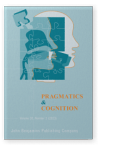Vol. 30:2 (2023) ► pp.412–443
Verbal irony and the implicitness of the echo
The processing of young and older adults
Speakers can express a critical, dissociative attitude by being ironic. According to the Echoic account of verbal irony, this attitude targets a proposition that echoes a thought attributed to someone other than the speaker herself at the present time. This study investigated the role of echo in irony processing across the lifespan. Through a self-paced reading task, we assessed whether the degree of explicitness of the proposition echoed by the ironical statement and the age of the participant influenced irony processing. Our results show that, independently of age, ironic statements were costlier to process than literal statements, with aging further increasing difficulty. Crucially, our manipulation of the echo affected reading times: it was more complex to process irony when this echoed an implicature or an implicit expectation, particularly for older adults. This work corroborates the role of the echo in verbal irony providing insights into age-related changes in irony processing.
Article outline
- 1.Introduction
- 1.1The role of the echo in understanding and processing irony
- 1.2Irony across the lifespan
- 2.The present study
- 2.1Method
- 2.1.1Participants
- 2.1.2Materials
- 2.1.3Pilot study for the implicit echo condition
- 2.1.4Procedure
- 2.2Predictions
- 2.1Method
- 3.Results
- 3.1Statistical analysis
- 3.2Descriptive statistics of reading times
- 3.3GLMMs of reading times of the target sentence
- 3.4GLMMs of reading times of the wrap-up sentence
- 3.5Analysis of the Autism Quotient (AQ) Test as Neuropsychological covariate measure
- 4.Discussion
- 4.1Does the degree of explicitness of the echo influence the processing of irony?
- 4.2Does age affect the processing of irony?
- 5.Conclusion
- Credit author statement
- Acknowledgments
- Notes
-
References
